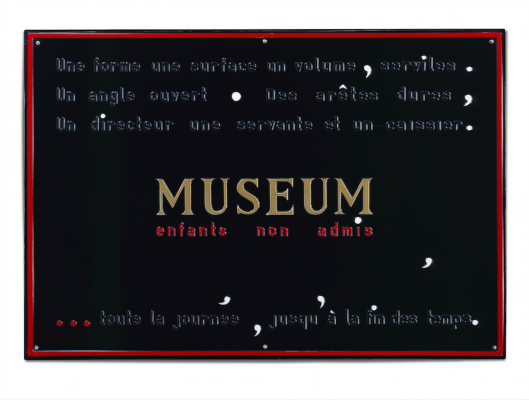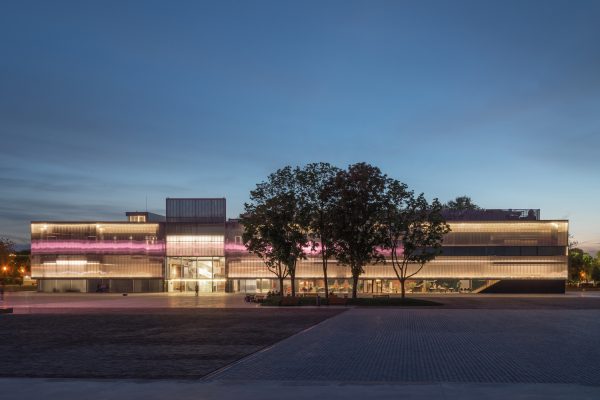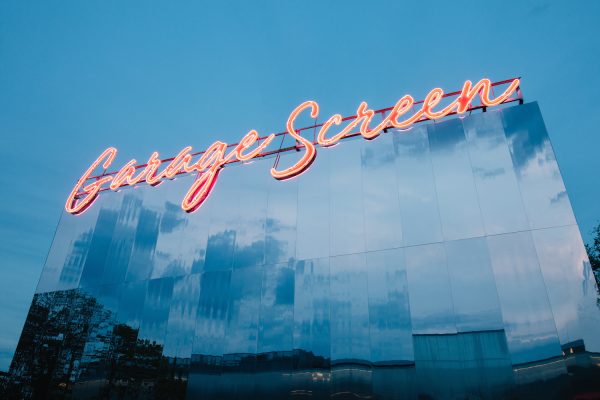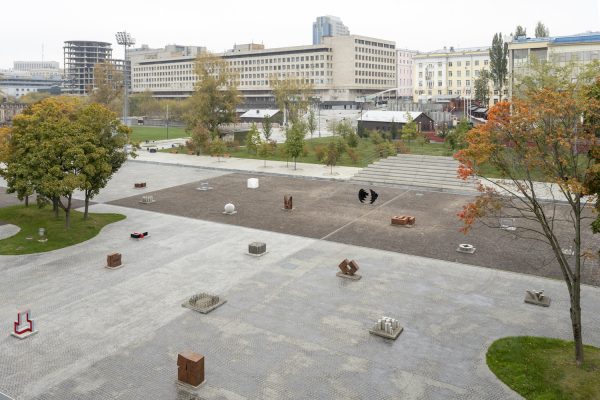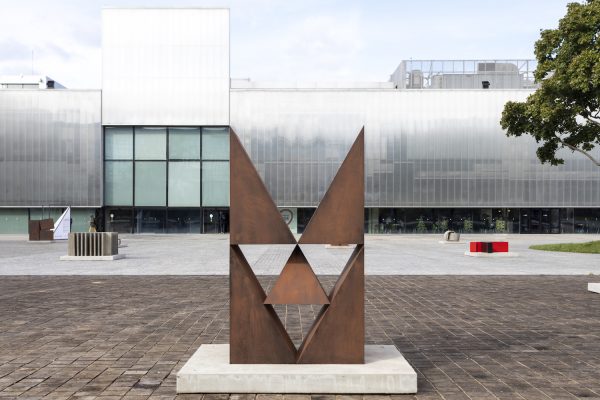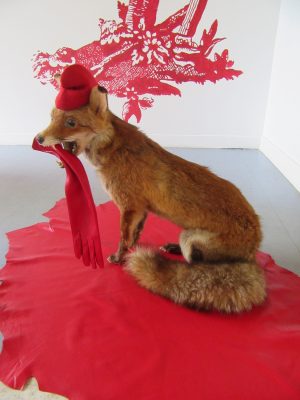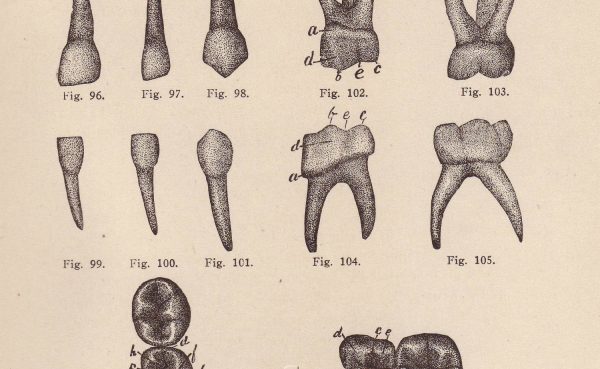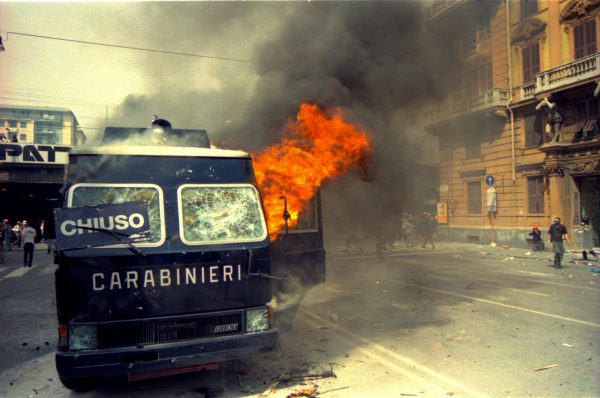When I arrive in Moscow, I am picked up from the airport by Roman, a patriotic taxi driver sent to collect me courtesy of The Garage Museum of Contemporary Art. Before I take my seat in the back of the BMW he is driving, Roman tells me that he loves his country, his wife, and Princess Diana, after whom he named his daughter. Having discovered this is my first visit to the city, he decides to take me on an impromptu tour of the centre. We drive past ‘Putin’s house’, aka the Kremlin, and St Basil’s Cathedral, where he launches with glee into a retelling of a legend of Ivan the Terrible, in which the original ‘Tsar of all Rus’ pokes out the eyes of the cathedral’s architect in order to ensure he never makes anything so beautiful again. Then onwards to the glass-domed shopping centre, GUM, itself a potted history of Russian politics: commissioned by Catherine the Great, nationalised after the revolution, briefly used by Stalin to display the body of his wife Nadezhda after she committed suicide, and today a mall so firmly at the lux end of the spectrum that even the ice cream concession is made by Bulgari. Last but not least on the tour is Pushkinskaya Square, to view ‘the first Soviet McDonald’s’, where today Roman buys his morning coffee. He opens the glove department and proudly shows me the evidence: full of empty cardboard cups.
This particular McDonald’s outlet opened on a January day in 1990. 30,000 people turned up, and in a sign of the coming change, employees handed out red flags with yellow logos to the crowds, the hammer and sickle replaced by the golden arches. The queue that snaked its way around the square that day would not be a one off. Come summer, visitors would still be waiting in line for eight hours, to experience the freedom of blocking their arteries in the US style. One year later, the Soviet Union would fall, and in the murky scramble that ensued, a few men would make their fortunes buying up state-owned resources at depressed prices and selling them on the international market for wild profit. They would come to be known as oligarchs (rule by the few), or kleptocrats (rule by thieves), and in the West, their existence has provided a new chapter to the James Bond-tinged, racialised narratives of Russian villainy popularised during the cold war. One of these men was Alexander Zhukov, father of Darya Zhukova, one of two founders of the Garage. Another was Roman Abramovic, Darya’s former husband, a man worth an estimated £9 billion, a figure so popular with Yeltsin and his family that he had his own apartment in the Kremlin, and the other founder of Garage. Like the Rockefellers and the Carnegies, who monopolised American trade in the late nineteenth century, once the dirty work was done, the new financial elite set about rebranding themselves as the standard-bearers of conscientious giving. Garage stands as a monument to the amphetamine pace of change.
It is perhaps little wonder, given the museum’s patronage, that it should appear to have everything an international contemporary art institution could want. During my visit, curatorial potential seems to have been wrung from the museum like champagne from a golden rag. I encounter live performance art in the loo (a first for me), and menus in the restaurant tailored to reflect the content of exhibitions. Even the interiors of the gallery walls have been opened up, turned into miniature art installations. Gorky Park, where today the museum is situated, has also benefitted from Garage’s financial clout and eye for detail. This year the museum unveiled Russia’s largest outdoor public playground – a kind of Tatlin-esque, epic fantasy of intelligent, communal play, where children can build their own water fountains, and where the bodies making use of the elaborate machinery in the sand pit look more like miniature civil engineers than children.
When Garage opened in 2008, in a former bus depot, Amy Winehouse was flown in to provide the entertainment. The museum turns ten this year – the reason for my visit – and in the decade since, a curatorial strategy has been implemented to bring glitzy blue-chip artists to Moscow. The roster – including Takashi Murukami, Donald Judd, Cindy Sherman, Antony Gormley, and Jeff Koons – reflects a kind of generic global glamour. (The bigger the names, the better.) The inaugural exhibition of Ilya and Emilia Kabakov, however, indicated a more interesting intent: a wish to produce a canon of artists outlawed from public exhibition during the USSR. This autumn, the once-exiled Kabakovs’ paintings and installations – depicting fantastical and impossible escape routes from Soviet Russia, whether catapulting through ceilings or drifting up into the ether – are on show in Moscow’s state owned New Tretyakov Museum of Art, an extraordinary embrace by the powers that be for artists once forced to exhibit in secret.
The bus depot has since become the permanent home of another of Zukhova’s projects, the Jewish Museum of Tolerance; since 2015 Garage has been housed in a former Soviet public canteen, converted by Rem Koolhaas’s architecture firm, OMA. A giant rectangular box covered in semi-opaque polycarbonate, the building reflects the cold, grey Moscow sky, and dominates Gorky Park – an area of the city Garage has also helped convert into the sort of destination that would not look out of place in an Olympic village. On a tour of the museum, and to the excitement of the assembled foreign guests, who clearly enjoy a tale of Russian tenebrosity, a curator recounts how, when the renovation work began, a body was discovered in one of the derelict rooms. Koolhaas decided to preserve the canteen’s old Soviet staircase, as well as a small section of green tiled wall – a gesture of care, as one curator puts it, to the building’s history. Despite this archeologising, the entire building emanates the statement internationalism of the financial elite, and what remains of the Soviet structure is relegated to the standing of a vintage pair of earrings: a novel conversation starter, but ultimately decorative.
The building is not the only example of Soviet history sitting oddly within the new economic frame. Upstairs, I wander through the group exhibition The Fabric of Felicity, in which over forty artists from five continents have been brought together to illustrate a curatorial essay on the politics of clothing. Among the works on show is Hymns, rehearsals (2007) by Russian artist Olga Chernysheva. Six monitors are displayed on plinths, each playing documentary footage of staff in the Russian consumer industry practicing promotional company songs. ‘We are the leaders of Russian fast food, we’ll be first forever, our speciality dish is very good, the union of potatoes and labour,’ sing the employees of Kroshka-Kartoshka – middle-aged women dressed in red visors, yellow shirts, and tartan waistcoats. The lyrics echo Soviet propaganda, the outfits Wendy’s Burgers. Chernysheva’s films are a human portrait of those caught in the Venn diagram of rival ideologies. The voices and facial expressions of the staff at Kroshka-Kartoshka are unsure, their performance peppered with nervous laughter.
A similar ideological disorientation pervades The Modern Garden, a new public commission of sculptural works by Damian Ortega in the square directly in front of the museum. To make the sculptures, Ortega sourced corporate logos from a graphic design compendium, and remade them in concrete, metal, and plywood painted to imitate rust. Over coffee in the cafe, from which The Modern Garden can be viewed without having to face the cold, curator Katya Inozemtseva tells me that the original logos, like so much of modern and contemporary visual communication, are indebted to Russian Constructivism. Given the context in which they are shown, Ortega’s sculptures raise more questions than answers. Does he mean to reinstate the communal values of Constructivism, by turning the logos of big business into public monuments? Is he pointing out the way in which history is a material ready to be sculpted? Is he calling for a return to a time of utopian visionaries, or, by turning the designs into functionless, nostalgic follies, is he showing the old ways as definitively over? In a city of monuments freighted with explicit nationalistic and political messages, the ambiguous purpose of the work, its invitation to wonder, is compelling.
Also on show during my visit is a survey of the conceptual kook and Belgian heir to Rene Magritte and Marcel Duchamp, Marcel Broodthaers. I am told Broodthaers has something of a cult following in this part of the world – perhaps because his idiosyncratic, irreverent attitude to institutional authority is exactly the sort of display of individual agency repressed during Soviet times. Indeed, elsewhere in Gorky Park, Garage’s librarians are busy digitising an archive of ‘unofficial art’ – that which was displayed in secret, by artists like Ilya Kabakov, when Social Realism was the only style of art-making allowed.
In 1968, Broodthaers established a ‘conceptual’ museum, ‘The Museum of Modern Art, Department of Eagles’, the main focus of which was to draw attention to (and poke fun at) the structure and ideology of the European museum model. He sold gold ingots stamped with the Department of Eagles logo for twice the price of gold, in order to ‘fundraise’. He even attempted to sell the museum, advertising the sale on the cover of the catalogue for the Cologne Art Fair in 1971. (Nobody bought it.) A series of photographs at Garage show Broodthaers on the beach in Brussels in August 1969, drawing an outline of the museum’s floorpan in the sand, and wearing a cotton cap with a plastic visor, the word ‘museum’ handwritten across the crown. ‘DEFENSE ABSOLUE DE TOUCHER AUX OBJETS’, says a sign on a stick stuck into the sand, aping institutional authority by prohibiting visitors from touching any of the exhibits, which anyway do not exist. A photo taken later on that day shows the sand museum submerged by the high tide. All that remains is the bossy sign poking up above the water. At Gorky Park, Broodthaer’s beach photographs are a reminder of how quickly cultural institutions, and the ideological systems that support them, can rise and fall with the political tides. Only here, it is Zukhova and Abramovic who wear the museum hat, and in their moneyed foray into museum building, sand has been replaced with durable Koolhaas polycarbonate.
Before I leave Moscow, an intern from Garage is given the task of showing me the sights of the city, and as we walk the streets of central Moscow, I ask her why she volunteers. She is from Crimea, she tells me, and is currently unable to travel, which has scuppered her plans to study abroad. She likes working at Garage because the people there are open-minded. A person should be free to love who they want, say what they want, get married or not get married, consider themselves as equal to their fellow citizens regardless of ethnicity, sexuality or gender, and decide themselves if they want to have children. These beliefs, she says, which could place you in danger elsewhere in Russia society, are reflected at Garage in the programming and among the staff. For young people like her, the museum is a sanctuary for tolerance. The idea that an institution paid for by the spoils of those who sold a nation’s assets for personal gain should be the defender of egalitarian values is but another example of the ways in which contradiction seems to have become the status quo. At Red Square we stop by the pyramid tomb in which the body of Vladimir Lenin lies in state in perpetuity. In front of us, two young women in matching cashmere mini-dresses and Chanel handbags pose for a photographer with a foot-long camera. My guide says that they will have hired him for the day, to be their own private paparazzo – a popular pastime among the rich. Taking my cue, I ask what she thinks of the wealth that funds Garage. There are much worse things to spend your money on, she replies.
